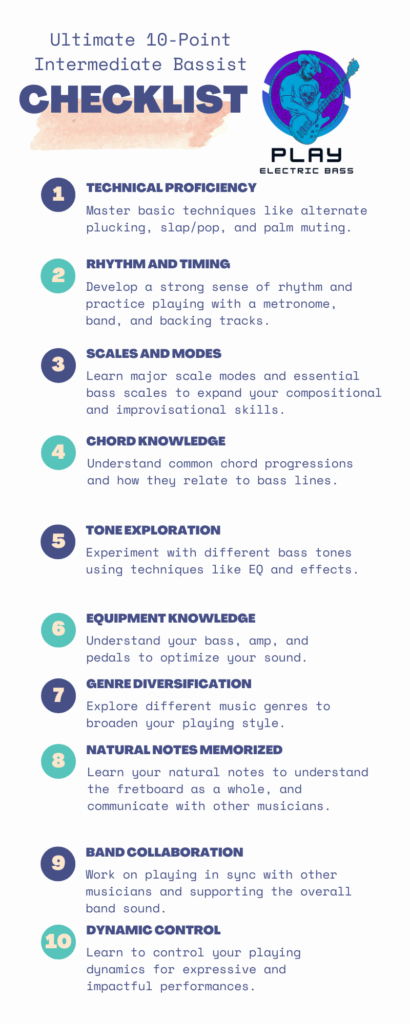Check out this comprehensive intermediate bassist checklist to ensure you’re covering all the essential techniques, theory, and practice routines necessary to take your bass playing to the next level.
I made this list because I’ve seen other bass and guitar instructors make similar lists. Basically, this is just my take on what an intermediate bassist checklist needs to include.
Learn from it, and don’t take it too seriously.

Intermediate Bassist Checklist PDF Download
Technical proficiency
Obviously you can’t be an intermediate bassist without an understanding of basic techniques.
Basic techniques for bass include palm muting, alternate plucking, slapping and popping, legato, and potentially tapping.
Rhythm and timing
It wouldn’t be an intermediate bassist checklist without mentioning rhythm and timing! After all, your role as a bassist is to lay down the groove, accompany the band, and keep everyone on time.
Scales and modes
Whether you like it or not you need to learn bass scales and modes.
And I don’t know why you wouldn’t like it, because learning scales and modes makes playing bass so freaking fun.
They help you understand composition, improvisation, and help you communicate with other musicians.
Start with my pentatonic scale bass lesson if you’re brand new to scales. It’s easy to play, and fun to apply.
Lastly, if you know jazz bass scales, then I can guarantee you’re already an intermediate bass player.
Chord knowledge
Related to scales, we have chord knowledge!
Sure, as a bassist your job isn’t really to play chords, but it’s important to understand chord progressions and how they relate to bass lines.
Tone exploration
Nobody likes a bad tone, and that’s why it’s important to explore different tones on the bass.
Start by trying to emulate the tones of your favorite bassists. From there, you can experiment with a variety of effects.
Equipment knowledge
Speaking of bass tone, you won’t have much success crafting a good bass tone without some basic equipment knowledge.
This includes understanding your bass guitar, your amplifier, and your pedals.
With the bass guitar, make sure you learn how to work all of your bass knobs and your pickups.
As for the bass amplifier, spend some time experimenting with its built-in equalizer. Lookup suggested settings for whatever type of music it is you want to play.
Lastly, understanding and using bass pedals will be essential in crafting your dream bass guitar tone.
Genre diversification
Genre diversification is not an essential step on this intermediate bassist checklist, but it certainly helps you stand out.
Knowing how to play a wide variety of genres will open up more professional opportunities for you, and it will make playing bass a lot more exciting.
Memorize natural notes
How in the heck are you going to play scales if you haven’t memorized your natural notes? The answer is simple: You won’t.
If I call out any note name and an associated scale, then you need to be able to play it. This is especially essential if you’re in a band.
My bass fretboard notes lesson makes it easy to memorize natural notes, if you haven’t already learned them.
You only need to memorize the natural notes in the beginning, because knowing the natural notes means you know where the accidentals (sharps/flats) are, too!
Band collaboration
As a bassist, you need to collaborate with other musicians to guide the rhythm and support the overall band’s sound.
Collaborating with other musicians will be a lot easier if you have good band chemistry and the desire to play the same genre of music.
Dynamic control
Dynamic control starts with understanding how a band fits together.
As a bassist, you are accompanying the band, and learning to control your playing dynamics will determine how expressive your band’s performances are.
Practice dynamics with bass lines you’re already familiar with. Practice these lines loudly, softly, and incorporate a variety of bass techniques, taking note of which ones best complement the bass line.
Intermediate bassist checklist summary
To summarize, your intermediate bassist checklist includes:
- Technical proficiency
- Rhythm and timing
- Scales and modes
- Chord knowldedge
- Tone exploration
- equipment knowledge
- genere diversification
- Memorizing natural notes
- Band collaboration
- Dynamic control
Getting down these 10 points of interest means you’re well on your way to becoming an upper-level bassist.
And remember, intermediate is a subjective term. It could include other things like improvisation, ear training, transcribing, and so many other things.
With that being said, look at this checklist as my opinion, and nothing more. I’m not trying to be controversial. I only wish to help! And speaking of helping, check out the bass guitar blog for more bass lessons.
Lastly, remember that playing bass is all about having fun. Don’t get caught up in anything taking away from that!

